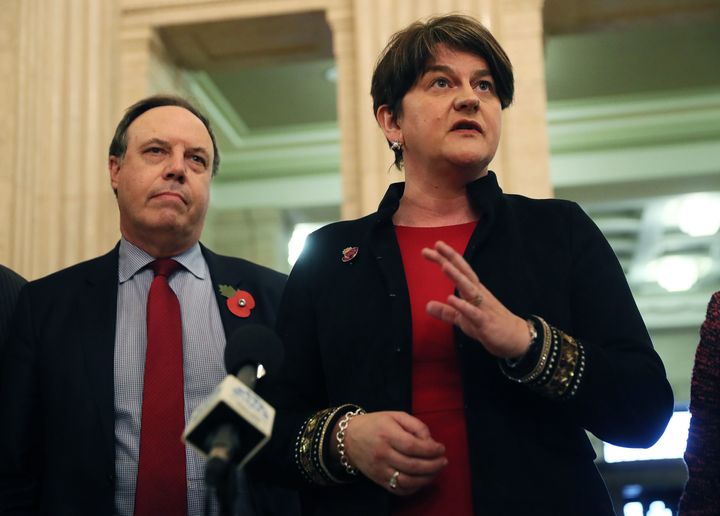
There was immigration. There was excessive regulation. There was the challenge to the principle of parliamentary sovereignty. But at no point during the EU referendum campaign was there an inkling that Northern Ireland would become the issue on which Britain’s withdrawal from the European Union would ultimately hinge.
Yet here we are. With five months to go until the UK is due to leave, a withdrawal agreement is in place – except for the question of what happens to the Irish border. The two sides can’t agree on the so-called Irish backstop – the system that would come into operation if their post-Brexit trade deal doesn’t produce a solution that would prevent a hard border.
The issue, simply put, is this. Both the UK and the EU are committed to avoiding the need for a border between Northern Ireland and the Republic. Indeed, the UK has gone further, underlining, its commitment to the “avoidance of a hard border, including any physical infrastructure or related checks and controls”.
So far so clear. However, while pledging its opposition to borders and infrastructure, the UK government was also making clear its determination to extract the UK from both the single market and the customs union. The problem with this is that it implies the need for two sorts of checks and control: customs (incorporating a raft of things, including rules of origin checks) and regulatory (to ensure that goods from each side adhere to the necessary standards).
And so the question becomes: where should these checks be carried out? And here we hit (yet) another roadblock. The European Union’s backstop would place the new border in the Irish Sea. Northern Ireland would remain in the customs union and in the single market for goods, which means that customs and regulatory checks would take place within the United Kingdom.
And this, it would seem, is unacceptable not only to the Democratic Unionist Party, but also to a number of other MPs, including Conservatives far removed from the European Research Group.
So, how to square this particularly circular circle? The EU knows what it wants and will not shift. It wants a Northern Ireland backstop written into the Brexit withdrawal agreement, which is to be settled by March 29 2019. It will not agree to placing a time limit on how long that arrangement would operate (if there was one, if would hardly be a backstop).
What the EU has not, to date, been willing to countenance is the idea that the backstop apply to the whole of the UK. This, it argues, is something for the negotiations over the future relationship, hence not something that can be included in the withdrawal agreement.
Given what the EU wants, the only way the UK government can sell a backstop agreement back home would be to ensure the future relationship deal obviates the need for the backstop at all. It is only via this relationship that Westminster can get the reassurance it needs that the backstop the EU insists it signs up to will never in fact be used.
So we’re back to the old problem of sequencing. In the short term, the withdrawal agreement will be finalised before a political declaration on the future relationship. But, politically, it is crucial for London that the two appear in public at the same time, as the latter will make the former more palatable. The political declaration will also be just that – a declaration. It won’t be a legally binding text. The future relationship itself will only be formally negotiated and agreed once the UK has left the EU.
So the question is how well the two sides manage to dress up the fact that, by signing a withdrawal agreement containing the backstop, the UK is in effect signing a blank cheque. This they will doubtless try to do using positive language (“we’re confident we can find a way to forge a future relationship that means the backstop won’t be needed”).
But the kinds of solution London has in mind will be hard to secure. An all-UK customs backstop would, in principle, be acceptable to the EU – but not if the UK, from the start, insists on a time limit for it. Why should the EU negotiate something the UK doesn’t really want that much?
And then there’s the sticky problem of the rules. The Chequers proposaldealt with the Irish issue by proposing a customs plan (one that isn’t acceptable to the EU, but leave that aside for the moment) and what the government has labelled “a common rulebook”, under which UK and EU rules for goods and agriculture would remain aligned.
The problem is that the EU doesn’t really like the idea. And without it, a large number of MPs (and not only those in the DUP) have a problem with the idea that a part of the UK will come under some laws over which parliament has no say.
So, again, the language will matter. London still thinks it can play chicken with its partners. The announcement that what are labelled full-scale parliamentary preparations for a no-deal Brexit will begin in the second week of November was intended – at least in part – to confront the Irish with a dilemma. It doesn’t want to insist on a backstop only to end up with no deal. So the hope in Whitehall is that Dublin might put pressure on its EU partners to give more in the political declaration than they otherwise would have.
Even if they do, of course, the fact remains that the declaration won’t be binding. So MPs wedded to a deal which guarantees the backstop will never be used are bound to be disappointed. It is at that moment – when parliament debates and votes on whatever is agreed – that we will know if Ireland has proved to be the Brexit circle that really couldn’t be squared.
This article was first published by The UK in A Changing Europe.
